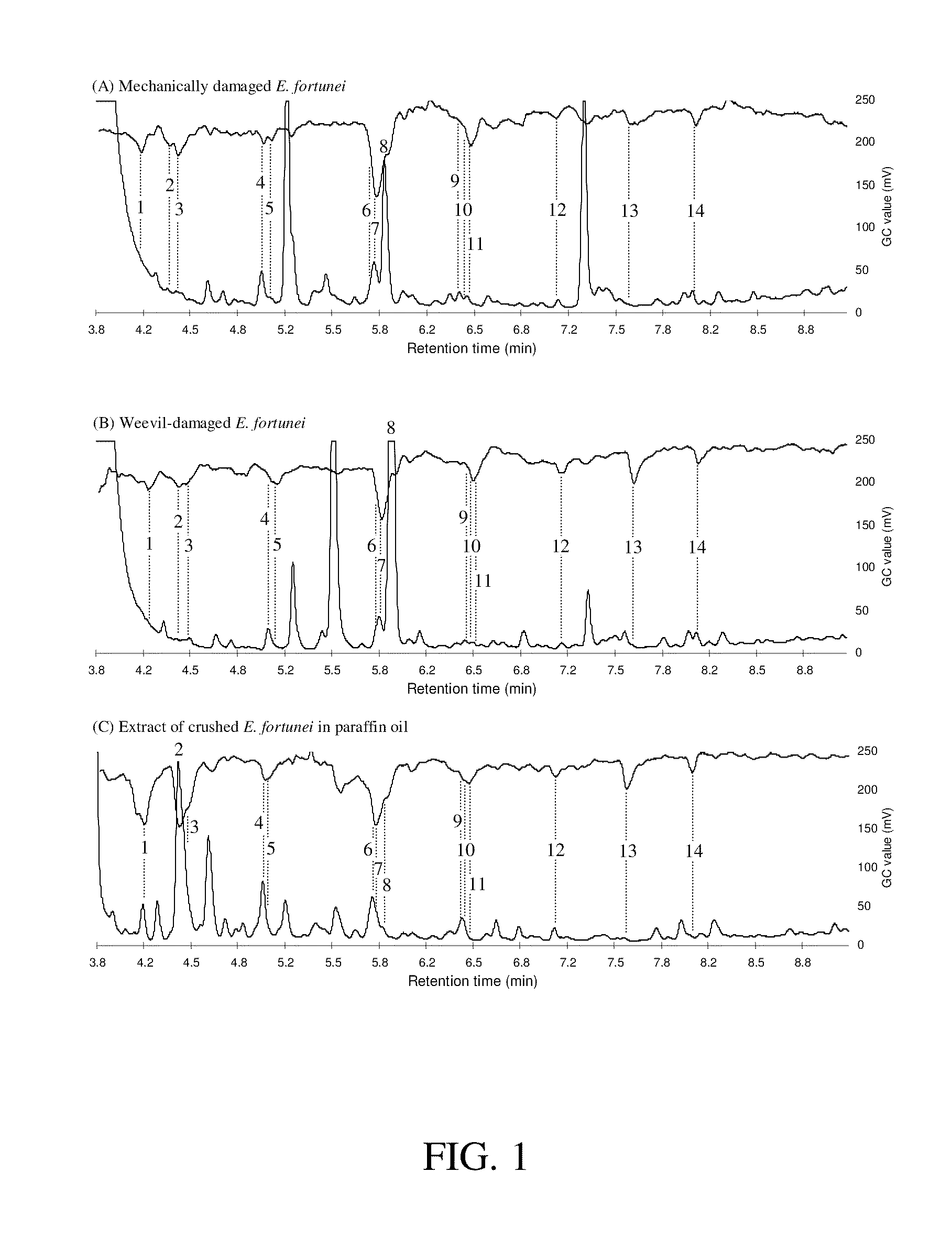Attractant compositions for weevils of the genus otiorhynchus and uses thereof
a technology of attractant composition and weevil, which is applied in the field of volatile organic compounds, can solve the problems of difficult combating otiorhynchus /i>weevil attacks, the most destructive pests, and the economic damage of considerable amount of weevils
- Summary
- Abstract
- Description
- Claims
- Application Information
AI Technical Summary
Benefits of technology
Problems solved by technology
Method used
Image
Examples
example 1
Results for Example 1
[0072]The headspace of mechanically damaged and weevil-damaged E. fortunei ‘Dart's Blanket’ plants and the leaf extract in paraffin oil showed a different pattern in release of compounds (FIG. 1). EAD-active compounds were present in all three headspace extracts and only differences in strength of antennal responses were found. Without being bound by theory it is believed that the differences in strength are related to the amount of the specific compounds present in the headspace of the different treatments. The amounts of compounds and strength of the antennal responses were not quantified in this research. The results show that of the 14 EAD-active volatiles (Z)-2-pentenol, (Z)-3-hexenol and (E)-2-hexenol were present in larger quantities in the headspace of the Euonymus extract in paraffin oil than in the headspace of mechanically and weevil-damaged Euonymus leading to clearly stronger antennal responses for these compounds in the extract compared to the plan...
example 2
[0080]The following example illustrates formulation a synergistic effect of light on attraction of Otiorhynchus weevils exposed attractant volatile organic compounds.
[0081]A solar powered LED light (X watts) was positioned 30 cm above the ground in close proximity of the plant containing an Otiorhynchus sp. traps (described hereinbelow in Example 3). The light contained a sensor that powered the LED during the overnight hours. The proportion of Otiorhynchus sulcatus adults in the traps near a light source the following morning were compared to those traps absent of light. Results are shown in Table 1 below.
Table 1. Proportion of Otiorhynchus weevils recaptured from two example traps tested with supplemental overnight (0.1-1.1 lux) in comparison to the same trap absent of light in 2010.
TABLE 1Proportion of Otiorhynchus weevils recaptured from two exampletraps tested with supplemental overnight (0.1-1.1 lux) in comparisonto the same trap absent of light in 2010.ExperimentaldateTrap AT...
example 3
[0083]The following example illustrates a trap designed for use in attracting and / or trapping Otiorhynchus weevils.
[0084]In an exemplary embodiment a trap designed specifically for trapping Otiorhynchus weevils is used. An Exemplary Otiorhynchus weevil trap (or “weevil trap”) is shown in FIG. 3.
[0085]In general, a trap designed for use in attracting and / or trapping Otiorhynchus weevils comprises a container which may be of variable form and size made of variable material. In an exemplary embodiment, a Wiffle® ball is used to construct the container part of the trap. Thus the trap comprises openings where weevils can enter. The number and size of openings are not important except in-so-far as the openings must be large enough for the weevils to enter.
[0086]In the interior of the trap is a “ruffle” which is serves as a hiding place for weevils once they enter the trap. The “ruffle” is, as generally understood a gathered or goffered fluted frill of lace or cloth or paper or any conveni...
PUM
| Property | Measurement | Unit |
|---|---|---|
| Illuminance | aaaaa | aaaaa |
| Volatility | aaaaa | aaaaa |
Abstract
Description
Claims
Application Information
 Login to View More
Login to View More - R&D
- Intellectual Property
- Life Sciences
- Materials
- Tech Scout
- Unparalleled Data Quality
- Higher Quality Content
- 60% Fewer Hallucinations
Browse by: Latest US Patents, China's latest patents, Technical Efficacy Thesaurus, Application Domain, Technology Topic, Popular Technical Reports.
© 2025 PatSnap. All rights reserved.Legal|Privacy policy|Modern Slavery Act Transparency Statement|Sitemap|About US| Contact US: help@patsnap.com



